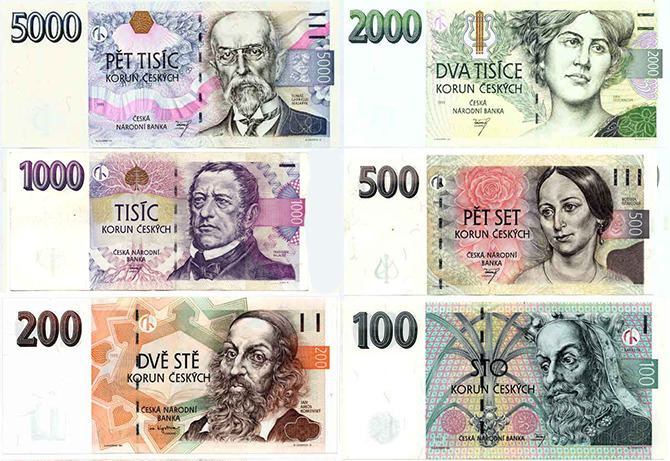Code CZK Symbol Kč | 1/100 haléř (defunct) haléř (defunct) h | |
 | ||
Plural The language(s) of this currency belong(s) to the Slavic languages. There is more than one way to construct plural forms. Freq. used 100, 200, 500, 1000, 2000 Kč | ||
The koruna (sign: Kč; code: CZK) is the currency of the Czech Republic since 1993, and in English it is sometimes referred to as Czech crown. The koruna is one of European Union's 11 currencies, and the Czech Republic is legally bound to adopt the euro currency in the future.
Contents
The official name in Czech is koruna česká (plural koruny české, though the zero-grade genitive plural form korun českých is used on banknotes and coins of value 5 Kč or higher). The ISO 4217 code is CZK and the local acronym is Kč, which is placed after the numeric value (e.g., "50 Kč"). One koruna equals 100 haléřů (abbreviated as "h", singular: haléř, nominative plural: haléře, genitive plural: haléřů – used with numbers higher or equal to 5 – e.g. 3 haléře, 8 haléřů), but haléře have been withdrawn, and the smallest unit of currency is 1 kč.
History
In 1892, the Austro-Hungarian krone (crown) replaced the Gulden, at the rate 1 Gulden = 2 crowns (that's also the reason why the 10-crown coin is still nicknamed "pětka" or "the five" by the Czechs). The name "Krone" was invented by the emperor, Franz Joseph I of Austria. After Austria-Hungary dissolved in 1918, the only successor state that kept the name of the currency, the crown, was Czechoslovakia. In the late 1920s, the Czechoslovak crown was the hardest currency in Europe. During the Second World War, the currency on the occupied Czech territory was artificially weakened. The Czechoslovak crown was restored after the war. It underwent a highly controversial monetary reform in 1953.
The Czech koruna replaced the Czechoslovak koruna when it was introduced in 1993 after the dissolution of Czechoslovakia. It first consisted of overstamped 20, 50, 100, 500, and 1000 Czechoslovak koruna banknotes, but a new series was properly introduced in 1993.
In November 2013, the Czech National Bank has intervened to weaken the exchange rate of the koruna through a monetary stimulus in order to stop the currency from excessive strengthening. In late 2016, the CNB stated that the return to conventional monetary policy was planned for mid-2017.
Euro adoption discussion
The Czech Republic planned to adopt the euro in 2010, but its government suspended that plan indefinitely in 2005. Although the country is economically well positioned to adopt the euro, there is considerable opposition to the move within the Czech Republic. According to a survey conducted in April 2014, only 16% of the Czech population was in favour of replacing the koruna with euro. As reported by an April 2016 survey by CVVM, (Public Opinion Research Center), this value has remained at nearly identical levels over the past two years, with merely 17% of the Czech population above 15 years old supporting euro adoption.
Coins
In 1993, coins were introduced in denominations of 10, 20 and 50 haléřů, 1, 2, 5, 10, 20 and 50 korun. The 10 and 20 haléřů coins were taken out of circulation by 31 October 2003, and the 50 haléřů coins were withdrawn from circulation on 31 August 2008 due to their diminishing purchasing power and circulation.
In 2000, the 10 and 20 korun coins were minted with different obverses to commemorate the Millennium. In 1993 & 1994 coins were minted in Winnipeg and Hamburg, then in the Czech Republic. All circulation coins were designed by Ladislav Kozak (1934–2007).
Since 1997, sets for collectors are also issued yearly with proof quality coins. There's also a tradition of issuing commemorative coins – including silver and gold coins – for numismatic purposes.
For a complete listing see: Commemorative coins of the Czech Republic.
Current exchange rates
The currency was on a record exchange rate run in 2008.
